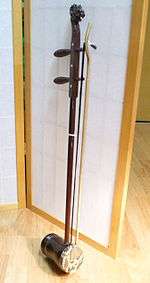Teochew string music

Teochew string music or Chaozhou xianshi (Chinese: 潮州弦诗; literally: "Chaozhou string-poem" also called "string-poem music") is classed as a type of sizhu music (chamber music for strings and woodwind, literally "silk/bamboo") although it typically uses stringed instruments only. It is found in northeastern Guangdong and parts of Fujian and also in regions with overseas Teochew populations, such as Singapore, Thailand, and the United States. The Chaoshan region of Guangdong, bordering on Fujian and comprising the cities of Chaozhou, Shantou and Jieyang, forms its own cultural sphere. Teahouses often accompany with Chaozhou music.
History
Developed from a fusion of elements, popular song, arias of Chinese opera, ancient melodies and pieces of Buddhist music, string music falls into two styles: Rujia yue(儒家乐) is music of the Confucian school that can be performed as an independent instrumental music genre or at weddings and other ceremonies and that aims at elegance and nobility, while Pengding yue(棚顶乐) is principally the music of the theatre, though it may be played independently: it cultivates a sober, rustic style.
Instruments
The instruments most commonly employed include several varieties of two-stringed bowed lutes; the zixian (字弦) erxian(二弦) or touxian (头弦) the lead instrument in the Hakka style, shorter and higher-pitched than the erxian), the tihu (of lower pitch than the zixian, adapted from the Cantonese gaohu) and the big and small yehu (coconut shell body), as well as several types of plucked lutes: the pipa, large and small sanxian (a fretless bass instrument like the shamisen), qinqin (four-stringed with short, fretted neck and round body), ruan (four-stringed with long, fretted neck and round body) and meihuaqin. Other than this, the zheng (zither) and yangqin (a hammered dulcimer thought to derive from the Iranian santur) are played as well as percussion instruments: a hand-held wooden clapper (muban), a pair of "temple" blocks (daban and fuban) that mark the beat, and a small drum (zhegu). Cello is sometimes also used, particularly in the style performed in the area of Shantou.
Characteristics
The ten characteristic compositions of xianshi yue are
- Zhaojun Yuan (昭君怨, Grief of Wang Zhaojun)
- Xiaotaohong (小桃红)
- Hanya Xishui (寒鸦溪水, Jackdaws Play in the Water)
- Huangli Ci (黄鹂词, The Oriole's Cry)
- Yue'er Gao (月儿高, High Moon)
- Dababan (大八板, Great Eight Beats)
- Pingsha Luoyan (平沙落雁, Flock of Geese on the Shore)
- Fengqiuhuang (凤求凰, The Male Phoenix Seeks the Female)
- Wulianhuan (Five Knots of the Chain)
- Jinshang Tianhua (锦上添花, Adding Flowers upon Brocade)
The form of each of these pieces resembles a suite (taoqu) of variations upon a stock melody (qupai or "noted tune"). These are called ban or "beat" variations and follow an ordered sequence with changes of tempo and measure (most pieces have six or eight beat measures). Augmentation and diminution of the melody is used, so that it may repeatedly double in speed through the variations. The technique of cui introduces a division-like filling in of the melody with figures such as repeated notes and neighbouring or passing notes. Perfect-fourth transposition of the melody (fan) also occurs, though the tonal centre remains constant.
Four or five main modes (diao) are traditionally identified. However, while elsewhere in China such modes are mainly defined by absolute pitch and by the degree of the pentatonic scale that is taken as the key-note (thus setting the intervals of the scale), the xianshi conception of mode, rather like the Indian raga system, includes motif, ornament and intonation. Pitch is not absolute but the scale is usually constructed on a key-note approximating to western concert F - F#. Modes are pentatonic but all derive from a seven-note scale: no notice is taken of the starting and finishing tones of the melody in determining the mode and the key-note remains the same in every mode. Tunes may be adapted to a new mode, but the mode remains constant throughout any performance of the suite.
Apart from the major pentatonic scale two further tones, corresponding to a (sharp) perfect fourth and a (flat) major seventh, are employed. The "missing" steps of the scale in each mode may be used in ornament but are not part of main mode structure. The mode qingsan qingliu ("Light III Light VI") is the standard major pentatonic. But qingsan zhongliu ("Light III Heavy VI") calls for a heavy string-pressure upon the sixth degree, raising it to the seventh. Zhongsan zhongliu ("Heavy III Heavy VI"), similarly, applies this upward string-bend to the third degree as well, raising it to the fourth. The fourth common scale, called Huowu ("Live V"), resembles this last but avoids the plain third degree and instead uses a heavy vibrato on the second degree. This is said to be the most characteristic mode of the region.
Chaozhou drum music includes the big drum and gong, the small drum and gong, the dizi set drum and dong and su drum and gong ensembles. The current Chaozhou drum music is said to be similar to the form of the Drum and Wind Music of the Han and Tang Dynasties.
References
- Anon, Sizhu yue : musique poétique à cordes de Chaozhou, China.org, retrieved April 2009
- Prof. Mercedes M. Dujunco, The Birth of a New Mode? Modal Entities in the Chaozhou Xianshi String Ensemble Music Tradition of Guangdong, South China, in Ethnomusicology Online, Issue 8, 2003, University of Maryland, Baltimore County, retrieved April 2009